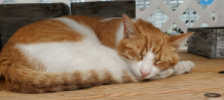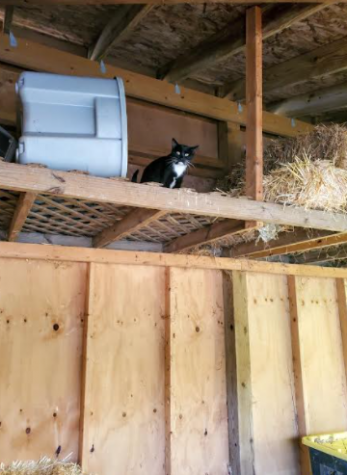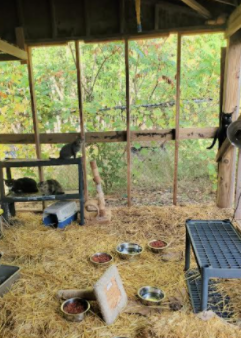These cats have a future

Tabby cat at Countryside Greenhouse, Holland MI
October 27, 2021
“We keep them out here. They’ll probably scatter when we come in.” The worker opens the wooden gate to the small barn-like enclosure and laughs as the cats do just that. The ground is covered in hay.
Food bowls heaping with fresh kibbles are sitting amidst water bowls and a cat scratcher, which keeps the cats occupied. Makeshift crates and small travel crates alike are filed along the edges, giving me the silly impression of a cat office.

Some of the cats retreat to shelves in the back and curl up into little balls, their beautiful green and yellow eyes analyzing us. One black cat with a distinct white splotch on its chest leaps to a ledge near the roof of the shelter and peers down at us with unconcealed curiosity.
The Problem
The Harbor Humane Society is arguably Holland’s most beloved shelter. It’s happy to help all animals; however, stray animals have recently become a big problem. The shelter has been overwhelmed by animals found by people. Some are even left outside by their door, which they urge people not to do. The shelter now gathers around half of its animals as strays.
That’s about 1,820 strays found by the shelter each year–and imagine, that’s only one shelter in Michigan. Michigan has 174 shelters, according to a Detroit newspaper. To add to the problem, some former stray cats may be unfit for adoption because they’re feral, a condition where the cat is unaccustomed to human contact and acts like an undomesticated animal.
A “Paw”-fect Solution
The Harbor Humane Society has found a method to deal with feral cats rescued from the streets: they develop them into working cats.
Working cats, otherwise known as barn cats, are former strays that can be used to keep rodents out of barns or other outdoor areas. The humane society keeps these cats in a barn-like enclosure outside before they’re adopted.
Cats in Businesses
An employee at the Harbor Humane Society agreed to show me to the barn where they keep these unadopted working cats. “We make sure to give them heated water bowls during the fall and winter, and we give them plenty of food,” the employee said as the black and white cat looked on from above.
Many adopt the cats to be used in barns, but there are also those who use the cats to keep pests out of their businesses. I have personally been to one of these businesses. The Countryside Greenhouse has multiple working cats. I’m always on the lookout for a small furry cat lying among the plants.
One time I found a tabby sprawled out on a shelf, enjoying a nap. My family came over and the cat started purring. When we asked the cashier about the cat, she explained that they keep about four cats around to keep their business mouse-free.
Letting an otherwise un-adoptable cat keep someone’s barn or business mouse-free sounds like a pretty efficient way to invite potential adopters, while also giving the cat’s life purpose.
The Harbor Humane employee agrees. She says that giving the cats a new role in life effectively “saves” them from a harsh life on the streets and gives them the ideal condition for a feral cat: ample space to roam and explore.
The Process
“We give them their vaccines and spay and neuter them first and then make sure that the adopters are a good fit before we give them the cat,” the Harbor Humane employee said. She explained that the shelter uses the same process for each cat.
They make sure to give the cats a check-up first and give them the required vaccinations. Then, they spay or neuter the cat so that there aren’t any accidental births. Although all those kittens would be adorable, that’s quite a handful for busy employees and barn workers to deal with.
If someone wishes to adopt a working cat, they must fill out a quick questionnaire to make sure they are a good fit. A good fit means that the person has a shelter that the cat can reside in, food and water to provide the cat with, and ample space for the cat to roam.
How to Adopt Online
On the Harbor Humane website, there is ample information on working cats. Under the adopt tab, a section labeled “Working Cat Program” pops up. The linked page includes a video on what

working cats are for and how to care for them. The same page also has the questionnaire attached for anyone interested in adopting a working cat.
The page says that “these cats come free of charge to qualifying adopters.” The shelter should have no problem giving these amazing cats a new life, as long as the adopter has a welcoming home. Adopting the feral cats out is such a great way to give them the enriching lives they deserve while also fixing the stray problem that is known to many throughout the country.
A quote from a working cat’s family is included on the Harbor Humane Society website. The message reads “McGuire is doing great at The Flanery House and is loving his new life, he is a true barn cat, loves snacking on mice in the garage, he has gotten himself a mole in the yard and plenty of cowbirds as well.” This message truly shows how the Working Cat Program helps so many feral cats begin to lead happier lives.




